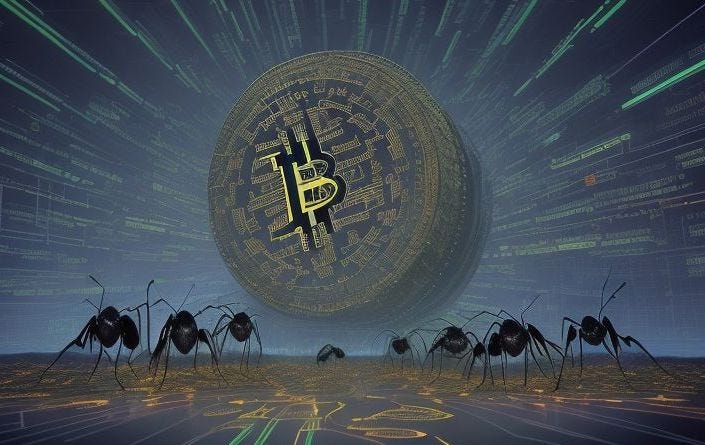Proof of Work
Episode XX. Block height: 854000. What is Proof of Work and why does it matter. An essential deep dive into Bitcoin's heart and soul.
In the digital dawn of decentralized dreams, where the old chains of finance lie shattered, a new paradigm emerges called Bitcoin. Its heart, a rhythmic and relentless pulse, beats to the tune of Proof of Work (PoW). In Bitcoin's universe, central authority is but a dim memory, replaced by the luminous ballet of decentralisation. Proof of Work choreographs this dance, inviting all who possess the requisite tools to join the performance. It is a symphony of independence, where power is dispersed among the many, and the music of consensus echoes across the Network. This dance, ever-evolving and inclusive, embodies the spirit of a trustless and liberated economy. This episode seeks to capture the essence of PoW's importance. No PoW, no Bitcoin, no Freedom! So let us dive in.
Consensus Mechanism
Proof of Work (POW) is a consensus mechanism that incentivises Network validation by rewarding miners for adding computational power and difficulty to the Network. Maintaining the integrity and security of all transactions is the ultimate objective behind the proof-of-work consensus mechanism. The term "Proof of Work" refers to the requirement that Bitcoin miners must prove they have expended computational effort in the form of real world energy (The link to the physical world). This process ensures that adding a new Bitcoin block requires significant resources, making it difficult for malicious actors to manipulate the blockchain. PoW allows for a distributed, open consensus mechanism where any participant with the necessary computational resources can become a miner and contribute to the Network’s security and validation processes.
Truth Machine
Bitcoin is often referred to as the "Truth Machine" because it establishes a decentralized and verifiable method of achieving consensus on the blockchain. By requiring miners to solve complex mathematical problems, PoW ensures that the addition of new blocks to the blockchain is computationally intensive and resistant to tampering. This process validates transactions and secures the Network, making it nearly impossible for any single entity to alter the transaction history. Consequently, it provides a transparent and trustless system where the consensus on the state of the ledger is maintained by the collective effort of the Network participants, ensuring the integrity and truthfulness of the data recorded on the blockchain.
Energy Consumption
Bitcoin's Proof of Work (PoW) mechanism requires a significant amount of energy because it relies on miners solving complex cryptographic puzzles, which demand substantial computational power. This process ensures Network security and integrity by making it exceedingly difficult and resource-intensive to alter transaction data. The high energy consumption stems from the sheer volume of computations needed to find the correct hash for each block, with miners worldwide competing to solve these puzzles first. The energy-intensive nature of PoW acts as a deterrent against attacks and ensures that adding new blocks to the blockchain remains a fair and decentralized process. The more energy the Network uses, the more secure Bitcoin is. This means that Bitcoin energy consumption is a feature and not a bug.
How it Works
The operation of PoW in Bitcoin involves several key steps. When a user initiates a transaction, it is broadcasted to the Bitcoin Network and grouped with other transactions into a mempool, a pool of unconfirmed transactions. Miners then select transactions, ranked according to the transaction fee selected by the user, from the mempool to form a candidate block. This block includes the transactions and a header containing the previous block's hash (forming the blockchain), a timestamp, and a nonce, a random number used for hashing. Here is an example of Bitcoin Block 851415:
Miners compete to find a valid hash by repeatedly hashing the block header, incrementing the nonce each time. They aim to find a hash that meets the Network‘s difficulty target, which requires the hash to begin with a certain number of leading zeros. The more zeros, the more difficult it is to find the hash. Once a miner finds a valid hash, the block is broadcasted to the Network. Other Bitcoin nodes validate the block, and if it fulfills the Bitcoin rules, they add it to their copy of the blockchain and distribute it to other nodes, so that every node in the Bitcoin Network is up-to-date.
NOTE: Bitcoin node runners are the ones enforcing the Bitcoin Network rules. Thus, running your own Bitcoin node is crucial for ensuring the security, privacy, and decentralization of the Bitcoin Network. By operating a full node, you verify transactions and blocks independently without relying on third-party services, which enhances the integrity and trustworthiness of the information you receive.
“Bitcoin is not ruled by Bitcoin-Miners but by Node-Runners.”
Mining Reward
The miner who successfully adds a new block is rewarded with newly mined bitcoin (the block reward) and transaction fees from the included transactions. Mining rewards are a critical incentive for miners. Initially, the reward for mining a block was 50 Bitcoin. However, to control the supply of Bitcoin and mimic the scarcity of precious metals, the reward halves approximately every four years (210,000 blocks) in an event known as "halving." The first halving occurred in 2012, reducing the reward to 25 bitcoin. Subsequent halvings occurred in 2016 (12.5 bitcoin), 2020 (6.25 bitcoin) and earlier this year (3.125 bitcoin). This halving process will continue until the total supply of Bitcoin reaches 21 million, projected to occur around 2140.
As you can imagine, the Bitcoin halving is a difficult event for miners because it reduces the block reward by 50%, directly cutting their revenue while their operational costs, such as electricity and hardware, remain constant. This squeeze on profitability forces less efficient miners out of the market, intensifying competition. Despite these challenges, the halving is essential to control the supply of new Bitcoin, maintaining scarcity and mitigating inflation. This built-in scarcity mechanism helps to preserve Bitcoin's value over time, ensuring its long-term viability and stability by enforcing its deflationary nature and ensuring that Bitcoin production in the form of mining remains efficient.
Difficulty Adjustment
In addition to the halving, an algorithm called the difficulty adjustment ensures that it will take the entire Bitcoin Network a fixed set of time to validate new blocks of transactions. The difficulty adjustment occurs approximately every 2,016 blocks (about once every two weeks) to maintain the target block time of approximately 10 minutes. This means that miners coming and going from the Network on an individual basis do nothing to affect the difficulty level minute to minute or day to day. This mechanism prevents any single entity from easily taking control of the Network. The computational effort required for PoW makes it extremely costly and time-consuming for malicious actors to alter the transaction history or double-spend coins.
Sybil Attack
Proof of Work (PoW) effectively protects Bitcoin from Sybil attacks by requiring significant computational power to influence the Network. To execute a Sybil attack, an adversary must control over 50% of the Network’s total computational power, a feat that is prohibitively expensive and practically unfeasible in a decentralised Network powered by proof of work, making Bitcoin resilient against fraudulent activities.
Double Spending
Furthermore, PoW plays a crucial role in preventing double-spending, a fundamental challenge in digital currencies. Double-spending refers to the risk that a digital currency can be spent twice, undermining its value and trustworthiness. In the Bitcoin Network, the PoW mechanism ensures that once a transaction is added to the blockchain, it is computationally impractical to alter it. Each block, once validated and added, is linked to the previous block through cryptographic hashes, creating a secure and immutable chain of transactions. The energy-intensive nature of PoW acts as a deterrent against malicious behavior. For a fraudster to successfully double-spend, they would need to re-mine all subsequent blocks faster than the rest of the Network, which requires an enormous amount of computational power and energy. This high cost of attack makes Bitcoin's PoW a robust defense mechanism against various types of fraudulent activities, and the use of real-world energy is necessary.
Proof of Stake
Whereas PoW ensures decentralisation, Proof of Stake (PoS), the consensus mechanism most altcoins, including Ethereum, use, leads to centralization because it inherently benefits those who already hold significant amounts of the cryptocurrency. In PoS, validators are chosen to create new blocks and validate transactions based on the number of coins they hold and are willing to "stake" as collateral. This means that wealthier participants with larger stakes have a higher probability of being selected, earning more rewards and further increasing their stake over time. This feedback loop leads to an inevitable concentration of power among a small group of stakeholders, reducing the Network’s decentralisation and potentially making it more susceptible to collusion and manipulation. It is no surprise that big corporations and governments are in favor of the PoS consensus mechanism because being in control is everything for them.
Conclusion
Proof of Work, the lifeblood of Bitcoin, flows with a rhythm that is both fierce and fair. It secures the Network with unyielding strength, decentralises power with graceful balance, aligns incentives with harmonious purpose, and shields against the shadows with unwavering resolve. In the grand opera of digital currency, PoW is the maestro, conducting a symphony of security and freedom. Its demanding energy requirements and computational challenges create a high barrier to entry, deterring malicious actors and ensuring that the ledger remains immutable and transparent. Through this relentless and robust mechanism, PoW maintains the integrity and trustworthiness of the Bitcoin Network, fostering a decentralised and resilient financial ecosystem.
The End
That's it for this episode. I hope you got some valuable information from this one. Don’t forget: Proof of Work, using a significant amount of energy, is essential for Bitcoin’s decentralisation and security! Thanks for reading, and see you in the next one.
₿ critical, ₿ informed, ₿ prepared. Yours,
Education for everyone
Pure, independent and free education. If you want to support my work, you can donate Sats via Lightning. I truly appreciate it!
Not your keys, not your coins
Get yourself a proper hardware wallet: The Bitbox Bitcoin-only! is my favourite. Swiss made, Great customer support and worldwide shipment.
Education is key
[1] Andreas Antonopoulos, Mastering Bitcoin
[2] Yan Pritzker, Inventing Bitcoin
[3] Jim Crawford, The Genesis Block
[4] Jack Parkin: Money, Code, Space
[5] Einundzwanzig Magazin (German), Proof of Work
[6] Ryan Holiday, Ego is the Enemy
[7] Feargus Greenwood, Unlearn the Lies








He Carl, nice piece you write. Only Noted 1 small thing. You wrote: "By requiring miners to solve complex mathematical problems", but I don't think this is right. Miners are just guessing random numbers. Keep up the good work!